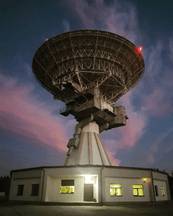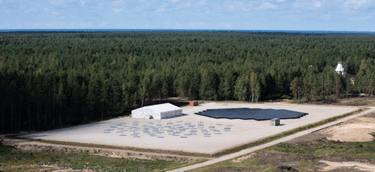This web page is created within BALTICS project funded from the European Union’s Horizon2020 Research and Innovation Programme under grant agreement No.692257.
Analysis of electromagnetic interference impact on radio astronomical observations
2020. gada 4. novembris
Radio astronomy is a fundamental science, which studies the near and far universe. Many cosmic phenomena produce electromagnetic radiation that can only be detected by large radio antennas, even though huge amounts of energy are sometimes emitted, due to strong attenuation of signals caused by immense distances to the astronomical objects. Therefore, the received power of signals emitted by cosmological objects is often many orders of magnitude weaker than that of artificial sources in the environment of a telescope. One illustrative example was the detection of the MASER emission from a cloud of water vapour at 11 109 lyr = 1023 km distance from Earth. To receive the signal with strength of about 2 mJy = -287 dB[Wm-2 Hz-1] it required 14 hours of observation of the source MGJ0414+0543 with a 100-m radio telescope.
Radio astronomical observatories utilize large aperture radio telescopes like RT-16 and RT-32 very often equipped with cryogenically cooled low-noise amplifiers or arrays with sometimes hundreds or thousands of smaller antennas like LOFAR-LATVIA HBA and LBA antenna fields. In combination with ultra-stable electronics, which allows to integrate the incoming signal for several hours in order to decrease the effective noise level, this leads to the enormous sensitivities necessary for detecting weak signals from the universe. Furthermore, a large variety of radio frequency interference (RFI) detection and mitigation techniques have been developed in the past two decades, from hardware-based solutions (e.g. superconducting filters) to real-time digital processing and convolutional neural networks.
Figure 1. VIRAC radiotelscopes RT-32, RT-16 and LOFAR-LATVIA LV614 HBA and LBA antenna fields.
Yet, even today the most effective interference mitigation is to ensure that harmful artificial signals are prevented from entering the telescope system in the first place. This is the aim of spectrum management for radio astronomy.
The International Telecommunication Union (ITU), in particular its radio-communication sector (ITU-R), acknowledged the importance of the radio astronomy service (RAS) already many decades ago in 1959 (Committee on Radio Astronomy Frequencies 2005). Protection criteria has been formulated to ensure that some of the frequency bands that are of highest importance to radio astronomy are kept free from RFI. As an example, one of the most important spectral lines for radio astronomy is the 21-cm transition of neutral atomic hydrogen (Hi) having a rest frequency of 1420.4 MHz. To guarantee interference-free measurements of Hi, no man-made emission is permitted in the frequency range between 1400 and 1427 MHz. This and other rules are part of the radio regulations by the ITU-R. Furthermore, a methodology to calculate limits on received interference is described in the recommendation ITU-R Rec. RA.769, 2003a, which is intended to guarantee a certain minimum quality of the recorded data for astronomers. The governments and administrations of all nations that are represented in the ITU-R have agreed to implement the rules and procedures decided by ITU-R bodies into their national law.
Emissions from Wind Turbines.
Harvesting wind energy is one of the few sustainable ways to generate energy with a low CO2 footprint. Considering the challenges and threats imposed by global climate change, all efforts to utilize renewable energy sources deserve our support.
Wind turbines (WT), as all other industrial devices in the vicinity of a radio telescope, have a potential of interference for astronomical observations. Therefore, coordination is needed to guarantee a beneficial coexistence between radio astronomy and societies interest in wind power utilization.
Figure 2. Radio Interference scenario between antenna and wind turbine.
In terms of electromagnetic interference (EMI) regulations, wind turbines count as industrial devices (Group 1, Class A), which are required to conform to the EN550011 (also known as CISPR-11) standard [4]: the electrical field strength measured at a distance of 30 m with a quasi-peak (QP) detector having a bandwidth of 120 kHz must not exceed 30 dBµV/m below 230 MHz or 37 dBµV/m between 230 MHz and 1 GHz. (Here we are using the CISPR-11 specification for the appropriate bands C and D, 30 MHz−1000 MHz.)
In addition to their main power generators and conversion equipment the wind power generators may also use computerised and networked control and telemetry equipment that may be covered by e.g. the recommendations provided in Recommendation ITU-R SM.329-12.
Theoretically, according to Recommendation ITU-R RA.769-2 the maximum acceptable interference spectrum-power-flux-density (pfd) is -253 dB(W/(Hz.m2)) for the radio-astronomy band near 611 MHz and -255 dB(W/(Hz.m2)) for the radio-astronomy band near 1413 MHz. Since the radio telescope is never pointed directly towards a wind turbine, interferences from all sources on the ground are received through side lobes of the antenna for which a gain of 0 dBi is assumed. The required path loss between wind turbine and radio telescope would be 130 dB for the radio-astronomy band near 611 MHz and 135 dB for the radio-astronomy band near 1413 MHz. Taking into account the terrain and the propagation model of Recommendation ITU-R P.452, the resulting geographical protection distances around the Radio Telescope depending on the terrain properties would be between 7 and 25 km for an assumed hub-height of 140 m .
To estimate WT influence on the radio observations, during the years 2015 and 2016 the radio monitoring services of Munich and Constance of the Federal Network Agency, Germany, performed measurements of electromagnetic radiation at some types of modern three-bladed wind energy plants which are deployed on-shore in Germany. The towers are in pipe construction with hub-heights between 134 and 140 m. The rotor-diameters ranged from 80 to 130 m. The nominal powers were 2.3 MW, 2.4 MW and 3.3 MW.
The physical measurements yielded the following main findings:
▪ The radiation levels of the measured wind turbines would be well below the limits specified in DIN EN 55011 (up to 1 GHz). They were 25 dB to 31 dB below the limits;
▪ The protection areas towards wind turbines necessary to ensure interference-free radio astronomical measurements are much lower than assumed in a worst case scenario based on exploiting the EMC limits in full.
Special attention is drawn to the fact that, especially at 1413 MHz, measurements were only carried out on three wind turbines, although these models are currently the ones most commonly used. The extremely low radiation levels measured at 1413 MHz are not legally binding for manufacturers and operators of wind turbines and should not be assumed to apply to all installed turbines. Yet the measurements do show that interference levels well below the limits in DIN EN 55011 are achievable with state-of-the-art technology and without additional efforts to suppress spurious radiation.
At a distance from WT of 200 m, the received interference power levels of the measured wind turbines were far below the noise levels from other sources (incl. man made noises) that have to be tolerated by telescope operators even today. However, most of the natural and background noise contributions are approximately white and can be effectively reduced by long integration times. As such, the study constitutes a worst-case scenario based on the assumption that, owing to its spectral characteristics, the interference from wind turbines cannot be eliminated during measurements whereas other noise levels can be.
The ASTRON engenders and system astronomers together with the Dutch regulatory agency (AT) made calculations and simulations about the effect of EMI and reflections on the LOFAR core (24 stations) from windfarm at the distance 5 – 10 km consisting from 24 WT. The limit accepted by ASTRON in the covenant is 35 dB below the EN55011 limit of 50 dBuV/m at 10 meters distance, at 100m height, measured in 120kHz BW with RMS detector. The most problematic LOFAR science is Epoch of Reionization with 2000 +hours of observations and slow pulsar research. During the two-week measurement campaign in Sept 2019 researchers found reflection from the blades at DAB frequencies transmitted from Denmark, of course, direct DAB signal from transmitter was stronger. It was very hard to measure levels below 15 dBuV/m and could only be done with LOFAR itself. But Wind Turbine manufacturers succeeded to build this windmill from scratch below the defined EMC limit. When the windmill is idle the level is even 0 dBuV/m.
For remote or ILT stations like Irbene LV614 a 2 km radius should be enough, where people have to inform about the plans to build WT or solar plants. At the distance about 20km from the LOFAR field, the attenuation due to distance and terrain are even with 50dBuV/m more than sufficient to bring it to below the noise in the received signals.
The direct path is always stronger than the reflected path, it means EMI signals are already present in the band. So this gives confidence that standard wind turbines have sufficiently low EMI for a single remote or international LOFAR station.
References:
❏ Winkel, B. and Jessner, A., “Compatibility Between Wind Turbines and the Radio Astronomy Service”, Journal of Astronomical Instrumentation, vol. 8, no. 1, 2019. doi:10.1142/S2251171719400026. https://arxiv.org/abs/1812.04731
❏ S&T Final Report “Measuring the EMI radiation with Lofar at the test turbine at location DEE-2.1 - Windpark De Drentse Monden en Oostermoer”. Reference: ST-WDMO-WTEM-REP-005, Version: 1.2 Date: 19 Nov 2019. https://www.rvo.nl/sites/default/files/2020/01/Bijlage_1_EM_Testing_Eindrapport_deel_1.pdf
❏ ECC Report 321 “Radio frequency test methods, tools and test results for wind turbines in relation to the Radio Astronomy Service”. Approved 2 October 2020 https://docdb.cept.org/download/0ccdddf8-5803/ECC%20Report%20321.pdf
❏ “I-LOFAR, Radio Astronomy and Radio Frequency Interference”. A submission, dated 27th Sept. 2019, made on behalf of the I-LOFAR Consortium to Offaly County Council in relation to the Offaly County Development plan 2021-2027. https://www.offaly.ie/eng/Services/Planning/County-Development-Plan-2021-2027/Stage-1-Pre-Draft/CDP-PD40-ILOFAR-Consortium.pdf
❏ Private discussions with Mr. Menno Norden, systems engineer at the department Astronomy and Operations (A&0) at ASTRON and with Mr. Waleed Madkour, CRAF Frequency Manager at JIVE-ERIC.






















